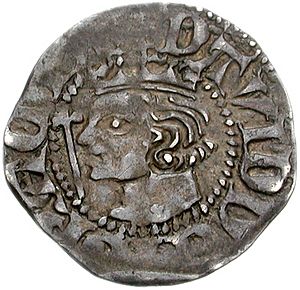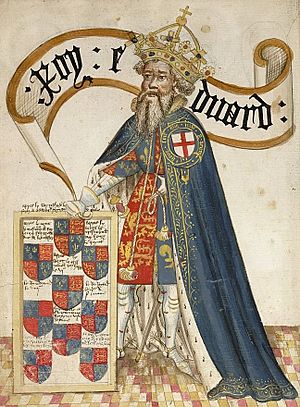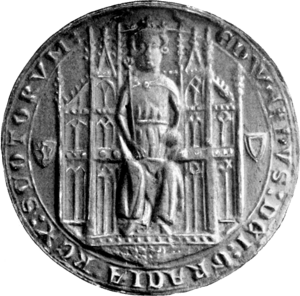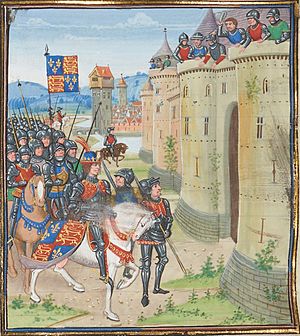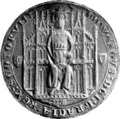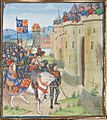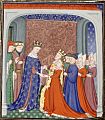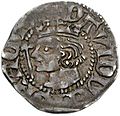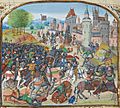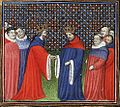Second War of Scottish Independence facts for kids
Quick facts for kids Second War of Scottish IndependenceAnglo-Scottish War of Succession |
|||||||
|---|---|---|---|---|---|---|---|
| Part of the Wars of Scottish Independence and the Hundred Years' War | |||||||
|
|||||||
| Belligerents | |||||||
| Commanders and leaders | |||||||
|
|||||||
| Strength | |||||||
| Up to 13,000 | Up to 9,000 | ||||||
| Casualties and losses | |||||||
| Unknown | Unknown | ||||||
The Second War of Scottish Independence was a big conflict that lasted from 1332 to 1357. It was a fight between Scotland and England, and it was part of the larger Wars of Scottish Independence. This war started because Edward III of England decided he no longer agreed with the Treaty of Northampton from 1328. That treaty had said that Robert Bruce's family was the rightful royal family of Scotland.
Edward III wanted to support Edward Balliol, who was the son of a former Scottish king, John Balliol. Edward Balliol had briefly been king of Scotland in 1332 but was quickly forced out. Edward III wanted Balliol to be king instead of David II, who was Robert Bruce's son and the true king of Scotland. The war ended in 1357 when David II was finally released from being held captive by the English. This war also played a part in starting the Hundred Years' War between England and France in 1337.
Contents
Why the War Started
The First War of Scottish Independence ended with the Treaty of Northampton in 1328. This treaty was important because England officially recognized Scotland as an independent country. It also said that Robert Bruce's family, including his son David II, were the rightful rulers of Scotland.
However, Edward III of England was not happy with this treaty. He believed England should have more control over Scotland. He saw a chance to change things by supporting Edward Balliol. Balliol was the son of John Balliol, who had been king of Scotland before Robert Bruce. Edward Balliol wanted to claim the Scottish throne for himself.
Edward Balliol's Claim
Edward Balliol was part of a group called the "Disinherited." These were Scottish nobles who had lost their lands in Scotland after Robert Bruce became king. They wanted their lands back and supported Balliol's claim to the throne. With Edward III's help, Balliol invaded Scotland in 1332. He even managed to be crowned king for a short time. But he was soon driven out by supporters of David II. This made Edward III even more determined to put Balliol back on the throne.
Key Players in the Conflict
This war involved important leaders from Scotland, England, and France. Each leader had their own reasons for fighting.
David II of Scotland
David II was the son of the famous Robert Bruce. He was very young when the war began. He had to fight hard to keep his family's right to rule Scotland. David II spent many years in exile in France and later as a prisoner in England.
Edward III of England
Edward III was a powerful king who wanted to expand England's influence. He saw Scotland as a way to gain more power. He strongly supported Edward Balliol and led many English armies into Scotland.
Edward Balliol
Edward Balliol was the English-backed claimant to the Scottish throne. He was a puppet king for England. He relied on English support to try and rule Scotland. However, he never gained full control or the loyalty of most Scots.
Important Events and Battles
The war saw many battles and sieges across Scotland. English armies often invaded, trying to control Scottish lands.
The Siege of Berwick (1333)
One of the most important early events was the Siege of Berwick in 1333. Berwick was a key town on the border between Scotland and England. Edward III led a large English army to besiege the town. The Scots tried to relieve Berwick, but they were defeated at the Battle of Halidon Hill. This led to Berwick falling to the English.
David II's Capture
Later in the war, in 1346, David II led a Scottish army into England. This was partly to help Scotland's ally, France, who was also fighting England in the Hundred Years' War. However, David II was captured by the English at the Battle of Neville's Cross. He was then held prisoner in England for many years.
The End of the War
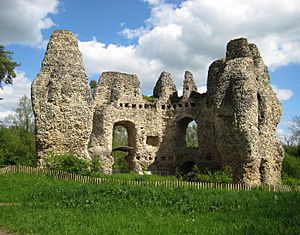
David II remained a prisoner in England for 11 years, from 1346 to 1357. During this time, Scotland was ruled by regents, who were nobles governing on behalf of the king. Eventually, a treaty was signed to secure David II's release.
In 1357, the Treaty of Berwick was agreed upon. This treaty allowed David II to return to Scotland. In exchange, Scotland had to pay a large ransom to England. Even though a ransom was paid, the war ended with a Scottish victory. Scotland remained an independent kingdom, and the Bruce dynasty continued to rule.
Connection to Other Wars
The Second War of Scottish Independence was closely linked to another major conflict: the Hundred Years' War. This was a long series of wars between England and France.
France and Scotland had a long-standing alliance called the "Auld Alliance." This meant they would support each other against England. When England invaded Scotland, France often helped Scotland. When England and France started fighting in 1337, Scotland's war with England became part of that larger conflict. This meant that England was fighting on two fronts, which made things harder for them.
Other pages
Images for kids
-
Edward III as head of the Order of the Garter, drawing c. 1430–40 in the Bruges Garter Book
-
Odiham Castle in Hampshire where David II was imprisoned from 1346 to 1357


